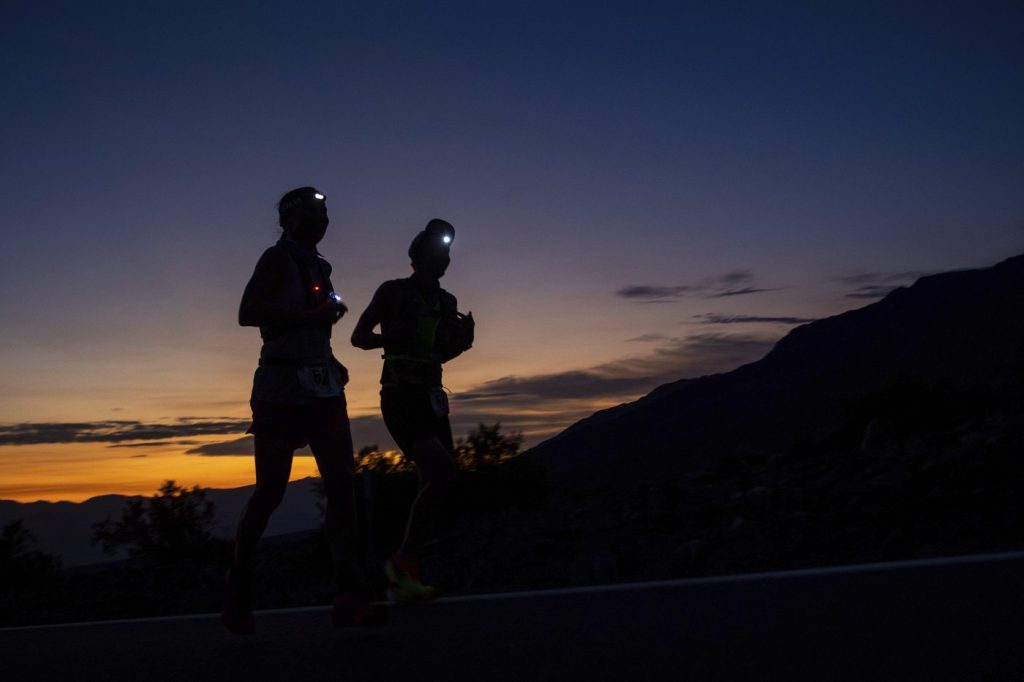First runners reach the finish in the annual Death Valley ultramarathon called the world’s toughest

DEATH VALLEY NATIONAL PARK, Calif. (AP) — The first few runners of an ultramarathon that steps off in desolate Death Valley hit the finish line early Wednesday, a little more than 24 hours after they began this year’s Badwater 135, billed as the world’s toughest foot race.
Ninety-seven runners launched the 48-hour race on Monday night, most of them starting with a light jog during a rainstorm that partially obscured the light of a nearly full moon.
The men and women ranging in age from 19 to 69 and hailing from 21 countries and 26 U.S. states were running amid daytime temperatures as high as 120 degrees Fahrenheit (48.8 Celsius) and night heat above 100 F (37.7 C). They ran over roadways open to traffic and passed through places with names like Furnace Creek, Devil’s Golf Course and Devil’s Cornfield.
Advertisement
“For me it’s all about seeing what I can do, you know, testing my own limits, seeing how well I can do these extreme things,” said 46-year-old runner Jessica Jones from Dauphin Island, Alabama, who was running her second Badwater 135, which starts in the valley’s Badwater basin.
Luke Thomas, 44, from San Diego, was running his fourth 135-mile (217-kilometer) ultramarathon this calendar year.
Thomas didn’t know if the humidity from the late Monday storm would make the first part of the race harder or easier. While running an ultramarathon race in Brazil in January, “the humidity almost killed me,” he said.
Results available online Wednesday morning showed that this year 37-year-old Shaun Burke, of Durango, Colorado finished first in the men’s division at 23 hours, 29 minutes and 0 seconds, and 52-year-old Line Caliskaner, of Lorenskog, Norway, led the women’s division, at 27 hours, 36 minutes and 27 seconds.
The fastest record for the race was set by 31-year-old Yoshihiko Ishikawa at 21 hours, 33 minutes and 1 second for the men’s division in 2019, and 41-year-old Ashley Paulson at 21 hours, 44 minutes and 35 seconds in the women’s division in 2023.
Advertisement
The race, which started in 1987, always takes place in mid-July, when temperatures peak in Death Valley National Park. The park has seen record-setting temperatures this month, including nine straight days of 125 F (51.6 C) or above.
It is so dangerous that a motorcyclist traveling in the park died from heat-related illness on July 6, and several more in his group fell ill. A woman with heat illness was rescued in the park on Thursday after she and a man got lost on a hike in an area called Badlands Loop as temperatures hit around 110 F (43.3 C) at 9:30 a.m.
No runner has died during the race, but a few people have landed in the hospital, said race director Chris Kostman, of AdventureCORPS, which organizes the race. The route actually dates back to a decade earlier when it was successfully completed by a solo runner, he said.
Participants start at the lowest point in North America at 282 feet (86 meters) below sea level. The finish line is 8,300 feet (2,530 meters) high at the Whitney Portal, the trailhead to California’s Mount Whitney, the highest point in the contiguous U.S.
Unlike more traditional marathons in which runners race close together, participants in the Badwater 135 are well spaced out on the road. The race is invitation only and limited to 100 runners who have run ultramarathons of at least 100 miles (160 kilometers) or longer over the span of three years. Only one-third of the runners each year can be repeat participants to allow others a chance.
Advertisement
When this year’s runners set out late Monday, temperatures were around 108 F (42.2 C). Their northbound path was illuminated by headlamps and the slightly obscured moonlight.
Organizers do not provide support along the course, which means each runner must bring a personal support team, usually three to four people in a minivan. There are no medical stations along the route, but Kostman said there is a small medical team that patrols the roadway.
The race is held from late Monday through Wednesday to avoid weekend visitors to the national park and increased traffic of people driving through the area from Las Vegas. Organizers coordinate with various federal, state and local government agencies, some of which must provide permits all along the route.
Kostman said the runners, support team members and race employees all consider themselves part of a family, often coming back to the park for family vacations.
“There’s a very collegial feel about it,” he said. “Everybody wants the other runners to do as best as they can.”
Advertisement
___
Snow reported from Phoenix.
Ty O’neil And Anita Snow, The Associated Press